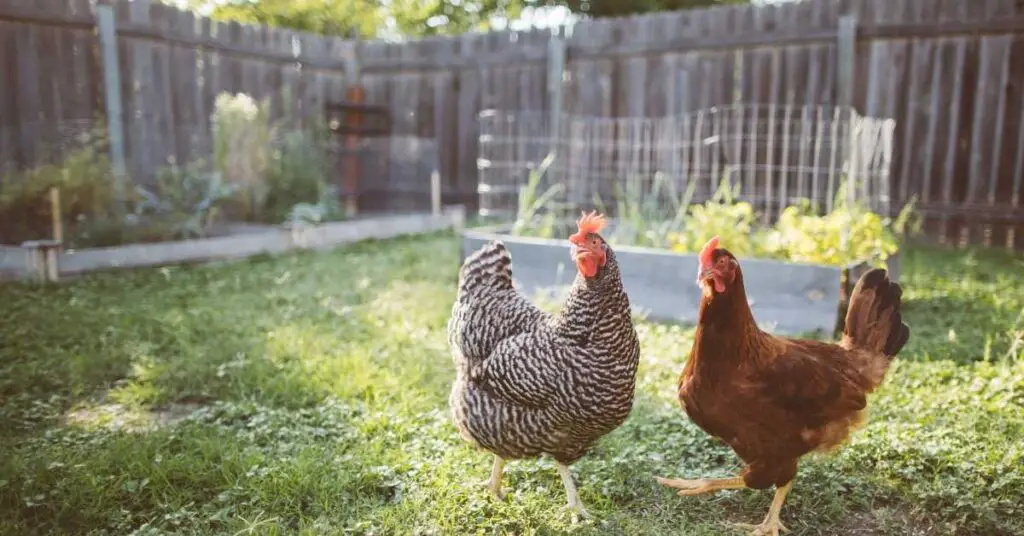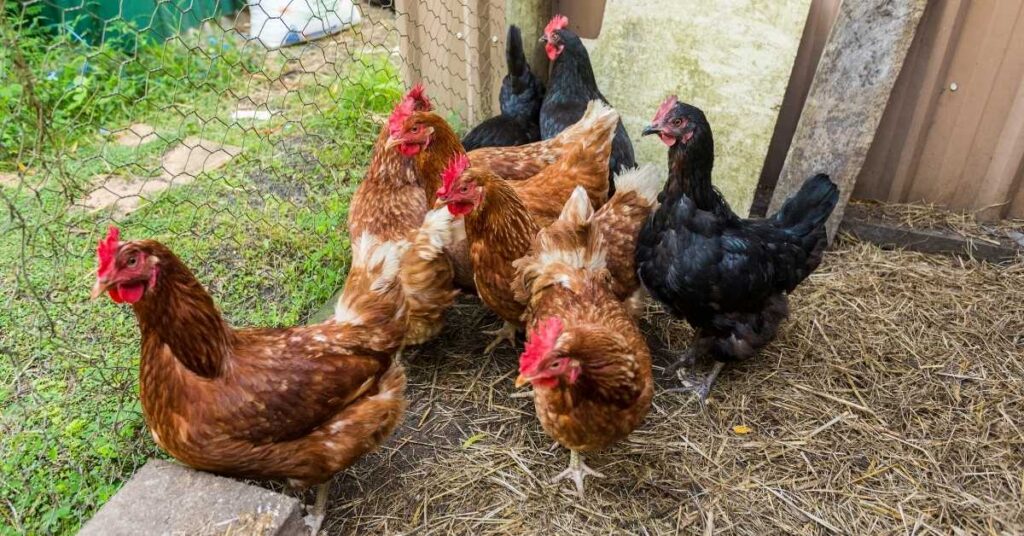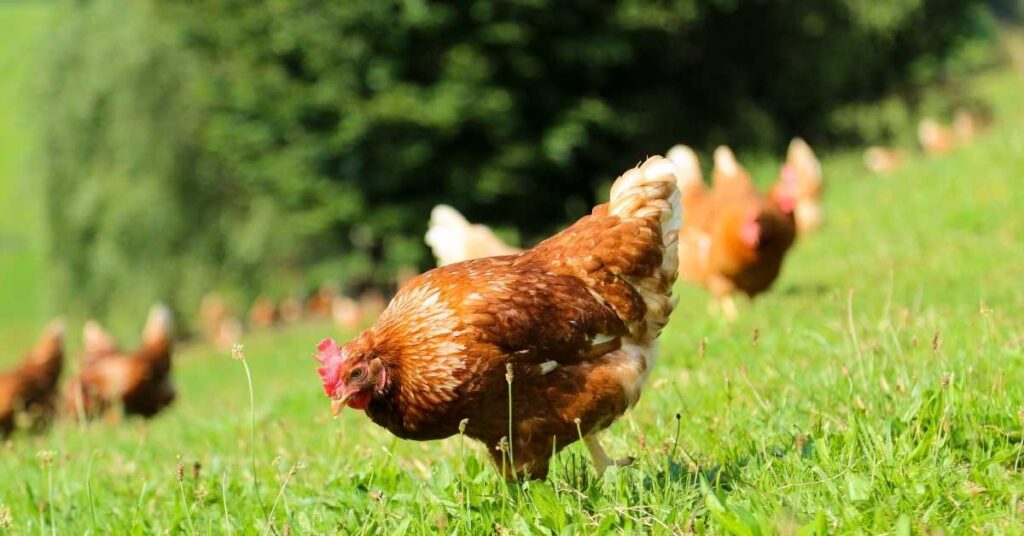Can chickens get stung by bees? Yes, chickens can get stung by bees. Typically, bees do not sting animals or humans under normal circumstances but rather only when the bees get stirred up. When bees get disturbed they become agitated and will swarm. This is when it is more likely for a person or animal to get stung by bees. So, if a chicken encounters a beehive that is swarming due to being disturbed by something then they can get stung.
In this article, we will delve into the anatomy of a chicken, explore the effects of bee stings on these feathered creatures, and provide you with preventive measures and natural remedies to ensure the safety and well-being of your beloved chickens.
Can Chickens Get Stung By Bees?
To truly understand whether chickens can get stung by bees, it is crucial to first familiarize ourselves with the anatomy of these fascinating creatures. Chickens have a complex physiological structure, with their bodies consisting of feathers, wings, beaks, and claws. Their sensitive skin is vulnerable to external factors, including the stingers of bees. With their keen senses and quick movements, chickens may unknowingly come into contact with bees, resulting in painful stings. Understanding the interaction between chickens and bees is essential in ensuring the health and safety of your flock.
As a chicken owner, your priority is to provide a safe and nurturing environment for your feathered friends. By learning about the effects of bee stings on chickens, you can take necessary precautions to protect them from these potentially harmful encounters.
Bee stings can cause pain, swelling, and inflammation in chickens, affecting their overall well-being and productivity. However, fear not! In this article, we will discuss preventive measures such as creating a bee-friendly environment and implementing natural remedies to alleviate the discomfort caused by bee stings.
So, let’s dive into the intriguing world of chickens and bee stings, where knowledge and care go hand in hand to ensure the happiness and health of your beloved flock.

The Anatomy of a Chicken
You’ll be surprised by how intricate a chicken’s anatomy is! From the outside, chickens may seem like simple creatures, but their internal structures are quite complex.
One fascinating aspect of chicken anatomy is the variations that exist among different breeds. Just like humans, chickens come in different shapes and sizes, and these variations can be seen in their bone structure, muscle development, and overall body proportions. Some breeds have long, slender bodies, while others are more compact and muscular. These variations are a result of selective breeding over many generations, with each breed being developed for specific purposes, such as meat production or egg-laying.
Now let’s take a closer look at the respiratory system of a chicken. Unlike mammals, chickens don’t have lungs that expand and contract. Instead, they have a unique respiratory system that allows them to efficiently exchange oxygen and carbon dioxide.
When a chicken breathes in, the air enters through its nostrils and travels down the trachea, which is a long tube located at the front of the neck. The trachea then splits into two bronchi, which lead to the lungs. However, unlike in mammals, the air doesn’t directly enter the lungs. Instead, it passes through tiny air sacs located throughout the chicken’s body. These air sacs act as reservoirs, storing the air and ensuring a constant flow of oxygen to the lungs. This unique respiratory system allows chickens to have a continuous supply of fresh air, even during physical activity, such as running or flying.
The anatomy of a chicken is far more intricate than meets the eye. The variations among different breeds showcase the diversity that exists within the chicken population. Additionally, the respiratory system of chickens is specially adapted to meet their unique needs, allowing for efficient oxygen exchange.
Understanding the intricacies of chicken anatomy not only provides insight into their biology but also fosters a sense of connection with these fascinating creatures.
Understanding Bee Stings
Contrary to popular belief, bee stings can actually be quite fascinating to understand. When a bee stings a chicken, it injects venom into the bird’s skin. This venom contains a mixture of proteins and peptides that can cause a range of reactions in chickens, from mild irritation to severe allergic reactions.
Some chickens may show signs of pain, swelling, and redness around the sting site, while others may experience more serious symptoms such as difficulty breathing, weakness, and even death in extreme cases. It is important for chicken owners to be aware of these potential reactions and to take appropriate measures to prevent and treat bee stings in their flock.
Bee stings and allergies are a concern for both beekeepers and chicken owners who coexist in the same area. The presence of beehives near chicken coops can increase the chances of chicken getting stung. It’s important for beekeepers to ensure that their hives are properly located and protected to minimize contact between bees and chickens.
Additionally, chicken owners should be aware of any signs of allergic reactions in their flock and seek veterinary care if necessary. It’s also recommended to provide a safe and secure environment for chickens to minimize the risk of encounters with bees.
By understanding the potential risks and taking appropriate precautions, beekeepers and chicken owners can coexist harmoniously while ensuring the well-being of both their bees and chickens.
Chicken Behavior Around Bees
Avoiding close proximity to beehives is essential for chickens as they can easily become agitated and exhibit erratic behavior. Chickens are naturally curious creatures, and their instinct to peck at anything that catches their attention can lead to unfortunate encounters with bees.
When chickens come across a beehive, their curiosity often gets the best of them, and they may attempt to investigate or even peck at the hive. This can result in the bees feeling threatened and becoming defensive, leading to potential stings for the chickens.
Beekeeping and chicken coexistence can be challenging, as both species have unique needs and behaviors. It’s important for beekeepers to take precautions to ensure the safety of their chickens. They can place the beehives in an area that is inaccessible to the chickens, such as behind a fence or elevated off the ground, to help prevent unwanted interactions. Additionally, providing the chickens with plenty of distractions and enrichment in their environment can help redirect their attention away from the beehives.
Understanding chicken behavior around bees is crucial for both beekeepers and chicken owners. By recognizing the potential risks and taking appropriate measures, such as keeping chickens away from beehives, we can create a harmonious coexistence between these two species. It’s important to remember that while chickens can be curious and sometimes get stung by bees, with proper management and precautions, they can peacefully coexist with beekeeping operations.

The Effects of Bee Stings on Chickens
When chickens are exposed to bee stings, their natural response may cause some discomfort, but it’s important to note that these incidents can be minimized with proper management and precautions. Chickens, like any other animals, have their instincts to protect themselves from potential threats.
When a chicken gets stung by a bee, it may experience pain, swelling, and irritation at the site of the sting. However, it’s crucial to understand the importance of bee conservation and the role of beekeeping practices in ensuring the coexistence of chickens and bees.
Bee stings on chickens can be minimized by implementing certain measures. One approach is to create a safe and secure environment for both chickens and bees. This can be achieved by placing chicken coops away from beehives, ensuring proper fencing to prevent chickens from accessing bee colonies, and providing ample space for chickens to roam freely without disturbing the bees.
Additionally, maintaining a clean and well-maintained chicken coop can help reduce the presence of pests and insects that may attract bees.
Beekeeping practices also play a significant role in minimizing the risks of bee stings on chickens. Beekeepers should focus on proper hive management, including regular inspections and maintenance, to prevent swarming and aggressive behavior in bees. It’s essential to provide bees with adequate sources of nectar and pollen, ensuring they have a healthy and balanced diet. By promoting a healthy and thriving bee population, beekeepers can reduce the chances of bees becoming defensive and stinging chickens.
Overall, understanding the importance of bee conservation and implementing appropriate beekeeping practices can enhance the coexistence of chickens and bees, minimizing the discomfort caused by bee stings on chickens.
Can You Put Bees Near Chicken Coop?
Yes, it is possible to put beehives near a chicken coop. In fact, it can be beneficial for both the bees and the chickens. Bees help with pollination, which can improve the productivity of plants around the coop, leading to better forage for the chickens. Additionally, chickens can help control pests that may bother the bees, such as beetles or mites. However, it is important to consider a few things when placing bees near a chicken coop:
- Distance: Bees should be placed a safe distance away from the chicken coop to avoid any conflicts. A recommended distance is at least 50 feet, although you may want to adjust it based on your specific circumstances.
- Flight Path: Bees fly in a straight line when leaving and returning to their hive. Ensure that the flight path of the bees does not intersect with the chicken coop or any areas where the chickens roam.
- Water Sources: Both bees and chickens require a water source nearby. Ensure that there is a clean water supply available for both species, but keep in mind that chickens may try to drink from the beehive’s water source, so it’s best to keep them separate.
- Safety Measures: Consider installing a secure fence or barrier around the beehives to prevent the chickens from accessing them. This will help prevent any accidental damage or disturbance to the hives.
Always monitor the interaction between the bees and chickens to ensure the well-being of both species.
Preventive Measures for Chicken Safety
To ensure the safety of our feathered friends, let’s explore some preventive measures that can help chickens coexist peacefully with their buzzing neighbors. Bees play an important role in pollination and are beneficial to our ecosystem, but their stings can cause distress and harm to chickens.
By implementing the following measures, you can minimize the risk of bee stings for your flock:
- Provide ample shade: Bees are attracted to sunlight and warmth, so ensuring that your chickens have access to shaded areas can reduce their exposure to bees. This can be achieved by planting trees or placing shade cloths over their outdoor areas.
- Avoid flowering plants near the coop: While flowers are beautiful, they are also a magnet for bees. By keeping flowering plants away from the chicken coop, you can decrease the likelihood of bees being drawn to the area.
- Keep the coop clean: Regularly cleaning the chicken coop and removing any spilled food or sugary substances will help deter bees. Bees are attracted to sweet smells, so maintaining a clean and odor-free environment will make your coop less appealing to them.
- Use bee-repellent plants: Certain plants, such as mint, lemongrass, and marigold, are known to repel bees. Consider planting these around your chicken coop to create a natural barrier and discourage bees from coming too close.
By following these preventive measures, you can create a safe environment for your chickens and minimize the risk of bee stings. Remember, chicken safety and bee sting prevention go hand in hand, ensuring a harmonious coexistence between your flock and their buzzing neighbors.
Natural Remedies for Bee Stings
Discover some effective natural remedies that can help soothe and alleviate the discomfort caused by bee stings. When a chicken gets stung by a bee, it can be quite distressing for both the bird and its owner. Thankfully, there are several natural remedies that can provide relief and promote healing.
One effective remedy is to apply a paste made from baking soda and water to the affected area. This mixture helps to neutralize the acidic venom and reduce inflammation. Another natural remedy is to apply aloe vera gel directly to the bee sting. Aloe vera has soothing properties that can help alleviate pain and reduce swelling.
Additionally, applying a cold compress, such as a cloth soaked in cold water or ice wrapped in a towel, can help numb the area and provide temporary relief. It is important to note that while these natural remedies can provide comfort, it’s also crucial to monitor the chicken for any signs of an allergic reaction and seek veterinary attention if necessary.
In terms of bee sting prevention, there are a few natural methods that can be employed to reduce the chances of chickens getting stung. Planting bee-repelling herbs such as mint, lemongrass, and citronella around the chicken coop can help deter bees from approaching the area. Additionally, keeping the coop clean and free of sweet-smelling substances, such as spilled feed or sugary treats, can help minimize the attraction of bees.
Regularly inspecting and repairing any openings in the coop can also prevent bees from entering and potentially stinging the chickens. Lastly, providing a shaded area in the chicken run can help reduce the likelihood of encounters with bees, as they’re more active in sunny areas.
By implementing these natural remedies and preventive measures, you can help ensure the safety and well-being of your chickens when it comes to bee stings.

Frequently Asked Questions
How do bees sting?
When a bee stings, it injects venom that causes various reactions, such as pain, swelling, and redness. Immediate treatment involves removing the stinger, cleaning the area, and applying ice. Seek medical attention if symptoms worsen or if you experience an allergic reaction.
What are the symptoms of a bee sting in humans?
If you’ve ever been stung by a bee, you know how painful it can be. Symptoms of a bee sting in humans include pain, redness, swelling, and itching. It’s important to know first aid remedies and how to prevent stings during outdoor activities.
Can chickens develop an allergy to bee stings?
Chickens can develop an allergy to bee stings, just like humans. This can lead to swelling, difficulty breathing, and even death. It’s important to monitor chicken behavior around beekeeping areas to prevent potential allergic reactions.
Are there any long-term effects of bee stings on chickens?
Bee stings can have lasting effects on chickens, causing inflammation, pain, and potentially leading to anaphylactic shock. Treatment options include antihistamines and removing the stinger. Protect your feathered friends from these buzzing hazards.
How can I protect my chickens from getting stung by bees?
To protect your chickens from bee stings, there are several protective measures you can take. Keep the chicken coop clean and free of debris, as this attracts bees. Plant natural deterrents like marigolds, mint, and basil around the coop to discourage bees.
Conclusion
In conclusion, yes, chickens can get stung by bees. It’s important to remember that all living things are connected, even chickens and bees in the farmyard. We need to look out for our feathered friends and take steps to keep them safe.
Whether you love keeping chickens at home or you’re just curious about nature, it’s good to know that bees and chickens, like all animals, have a special connection in the big picture of life.




